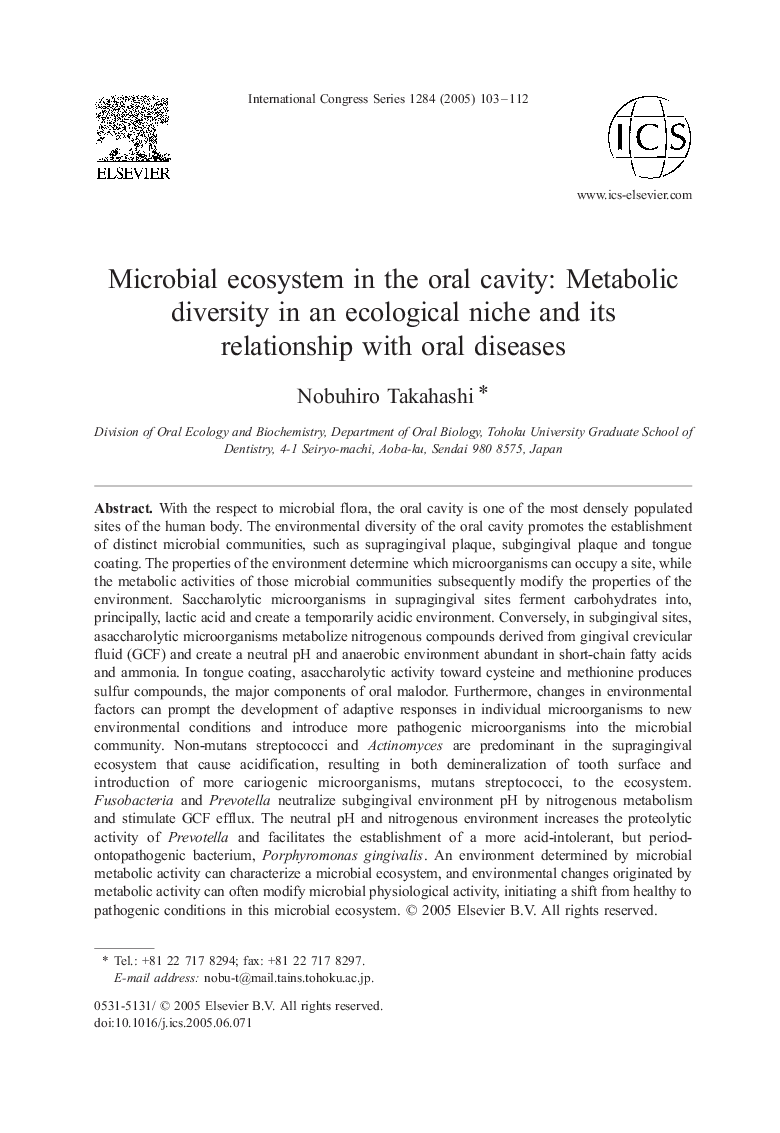| کد مقاله | کد نشریه | سال انتشار | مقاله انگلیسی | نسخه تمام متن |
|---|---|---|---|---|
| 9021362 | 1561373 | 2005 | 10 صفحه PDF | دانلود رایگان |
عنوان انگلیسی مقاله ISI
Microbial ecosystem in the oral cavity: Metabolic diversity in an ecological niche and its relationship with oral diseases
دانلود مقاله + سفارش ترجمه
دانلود مقاله ISI انگلیسی
رایگان برای ایرانیان
کلمات کلیدی
Microbial ecosystem - اکوسیستم میکروبیPeriodontal disease - بیماری پریودنتال یا پیرادندانیOral malodor - مالدور دهانیBacterial metabolism - متابولیسم باکتریProteolytic - پروتئولیتیکSubgingival plaque - پلاک زیر جلدیSupragingival plaque - پلاک ممکنDental caries - پوسیدگی دندانTongue coating - پوشش زبانCarbohydrate - کربوهیدرات
موضوعات مرتبط
علوم زیستی و بیوفناوری
بیوشیمی، ژنتیک و زیست شناسی مولکولی
زیست شناسی مولکولی
پیش نمایش صفحه اول مقاله

چکیده انگلیسی
With the respect to microbial flora, the oral cavity is one of the most densely populated sites of the human body. The environmental diversity of the oral cavity promotes the establishment of distinct microbial communities, such as supragingival plaque, subgingival plaque and tongue coating. The properties of the environment determine which microorganisms can occupy a site, while the metabolic activities of those microbial communities subsequently modify the properties of the environment. Saccharolytic microorganisms in supragingival sites ferment carbohydrates into, principally, lactic acid and create a temporarily acidic environment. Conversely, in subgingival sites, asaccharolytic microorganisms metabolize nitrogenous compounds derived from gingival crevicular fluid (GCF) and create a neutral pH and anaerobic environment abundant in short-chain fatty acids and ammonia. In tongue coating, asaccharolytic activity toward cysteine and methionine produces sulfur compounds, the major components of oral malodor. Furthermore, changes in environmental factors can prompt the development of adaptive responses in individual microorganisms to new environmental conditions and introduce more pathogenic microorganisms into the microbial community. Non-mutans streptococci and Actinomyces are predominant in the supragingival ecosystem that cause acidification, resulting in both demineralization of tooth surface and introduction of more cariogenic microorganisms, mutans streptococci, to the ecosystem. Fusobacteria and Prevotella neutralize subgingival environment pH by nitrogenous metabolism and stimulate GCF efflux. The neutral pH and nitrogenous environment increases the proteolytic activity of Prevotella and facilitates the establishment of a more acid-intolerant, but periodontopathogenic bacterium, Porphyromonas gingivalis. An environment determined by microbial metabolic activity can characterize a microbial ecosystem, and environmental changes originated by metabolic activity can often modify microbial physiological activity, initiating a shift from healthy to pathogenic conditions in this microbial ecosystem.
ناشر
Database: Elsevier - ScienceDirect (ساینس دایرکت)
Journal: International Congress Series - Volume 1284, September 2005, Pages 103-112
Journal: International Congress Series - Volume 1284, September 2005, Pages 103-112
نویسندگان
Nobuhiro Takahashi,